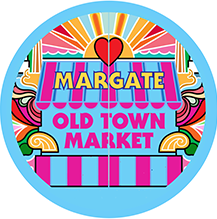About Margate Old Town Market

Our Beginning
A Century of Change: The History of Margate Old Town Market (1925–2025)
Over the past 100 years, Margate Old Town Market has undergone profound transformation, mirroring the fortunes of the town itself. From the post-war resilience of the 20th century to the creative revival of the 21st, the market has been both a barometer and a catalyst of change in this storied Kentish coastal town.
1920s–1940s: Tradition Amid Turbulence
In the early 20th century, Margate's Old Town Market was a modest but vital hub for local trade. Farmers, fishmongers, and butchers brought fresh goods to the square, supplying residents and seasonal visitors. This period saw the market embedded in daily life, though it was overshadowed by Margate's popularity as a seaside resort, where pleasure piers and promenades dominated the local economy.
The interwar years and WWII brought disruption. Rationing and the threat of air raids diminished commercial activity, but the market persisted as a space for community cohesion, with wartime "make do and mend" ethos visible in the wares on offer—second-hand goods, homegrown produce, and utility clothing.
1950s–1970s: Decline and Retreat
Post-war Margate saw a decline in traditional markets, as supermarkets and chain stores took hold. The Old Town itself suffered from neglect, with declining footfall and little investment. By the 1970s, Margate Old Town Market, like many rural and seaside markets across England, had contracted to a few stalwart traders—mostly older vendors selling antiques, bric-a-brac, and second-hand books.
1980s–1990s: Marginal but Resilient
Through the Thatcher era and into the early 1990s, Margate’s economic challenges deepened. Tourism continued to wane, and the Old Town became a byword for urban decay. However, this decline allowed marginalised and alternative economies to take root. Informal markets, pop-up stalls, and car boot sales began appearing, often held on weekends or as part of civic events. These kept the market spirit alive, if not formalised.
2000s–2010s: Revival and Reinvention
The turn of the millennium brought renewed attention to Margate. Artists and creatives, priced out of London, began to settle in the Old Town, attracted by its character and affordability. The opening of the Turner Contemporary in 2011 was a watershed moment. Margate's Old Town Market began to reinvent itself as a craft, vintage, and food market, aligning with broader trends in artisanal and experiential retail.
Heritage restoration efforts revitalised market spaces. Traders offered handmade goods, vintage clothing, and organic produce. The market became an essential part of Margate's cultural resurgence, attracting visitors from across the UK and Europe.
2020s–Present: Community, Culture, and Continuity
Today, Margate Old Town Market is a vibrant, seasonal institution blending heritage with innovation. The market now often operates as a curated event space, hosting food festivals, arts markets, and themed fairs. Localism, sustainability, and independent craft dominate its ethos.
While no longer a daily fixture, the market serves as a community anchor, drawing on Margate’s creative identity and deepening its reputation as a town of renewal and reinvention. The past century has not only witnessed the survival of Margate Old Town Market—but its rebirth as a symbol of local resilience, cultural reinvention, and the enduring spirit of English market life.
